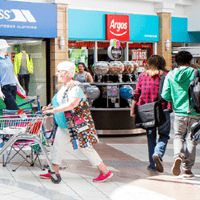It would be remiss to suggest that it has been plain sailing for retailers and ignore the challenges that have affected many high streets and shopping centres across the UK over the last decade.
High void rates, the rise of ecommerce and changing levels of consumer spending are all issues that can affect even the most successful retail places.
However, too often commentary on these issues masks the fact that many retail places work hard to successfully meet the needs of the consumer, or that even where high voids persist, occupied space might still be performing well.
Secondary retail locations are often too readily dismissed as being over spaced, irrelevant and of low quality to shoppers, retailers and ultimately to investors. There are around 1,400 shopping centres of all designations in the UK. Savills track around 850 of these (the others being too small to be monitored) and classify 390 (46%) as Secondary.
Within the Secondary sector there are various subclasses of shopping centre, including Community shopping centres (220 schemes). With varying degrees of quality and performance it is fair to say that not all schemes are equal. So how do we spot the winners?
Fundamental is fitting the offer to the catchment and giving shoppers what they need given an increasing array of choice for different consumer journeys. Successful retail places acknowledge competition and seek to provide a point of difference. This is not a new phenomenon, but is one that has often been underestimated in terms of the importance and increasing relevance of some secondary retail locations. Even tertiary retail places can provide a relevant function if they synchronise the offer to the catchment.
In town centres this includes thinking beyond retail; it includes social and public realm, health and services, community and civic, mixed-use and leisure. There has been a revival of market stalls, which when done successfully can bridge the divide between functional retail and leisure shopping trips, with a positive impact on footfall and helping to revive and regenerate the high street.
Premium shopping centre destinations draw shoppers in through their size and range of brands, aspirational fashion, department stores and extensive dining and leisure offer. While much of the offer competes with ecommerce, the point of difference is in theatre and experience that cannot yet be replicated online. Community shopping centres have a higher proportion of space taken up by convenience and retail services. However, as has been identified from our consumer research, these centres still require a broad range of brands including fashion and comparison goods.
The appropriate leisure offer for Secondary shopping centres needs particular consideration. Restaurants are relevant to leisure shopping trips, but are not the answer for all locations and could be excessive in Convenience based locations. As our research has shown, in local schemes F&B is an important resource, but the average spend will often only support the need for cafes and takeaways, not a full dining offer. This is perhaps counter to the assumption that a comprehensive leisure offer is the saviour of a shopping centre.
In Community shopping centres, the need for schemes to fit and effectively service the local catchment is crucial, but with the right retail mix and environment the property performance can be compelling.
Successful Community-based schemes tend to have above average occupation rates, with unit voids in Ellandi’s portfolio at 7.8% in 2016; more than half the rate across the wider Secondary shopping centre sector.
The below average vacancy rates within the Community shopping centre sector in particular, demonstrates how a strong ‘fit to catchment’ can have a positive impact on occupational demand, which in turn improves footfall. This is apparent when comparing the demographics of Ellandi’s centre exit surveys with that of the local catchments. The Acorn profiles of both is almost identical, which implies that their schemes’ appeal is drawing in shoppers from across their catchments as opposed to being skewed to a certain demographic group. The result has seen quarterly retail sales improve on the majority of centres, typically between 2-7% yoy.
.jpg)
.jpg)
.jpg)
.jpg)
.jpg)



.png)